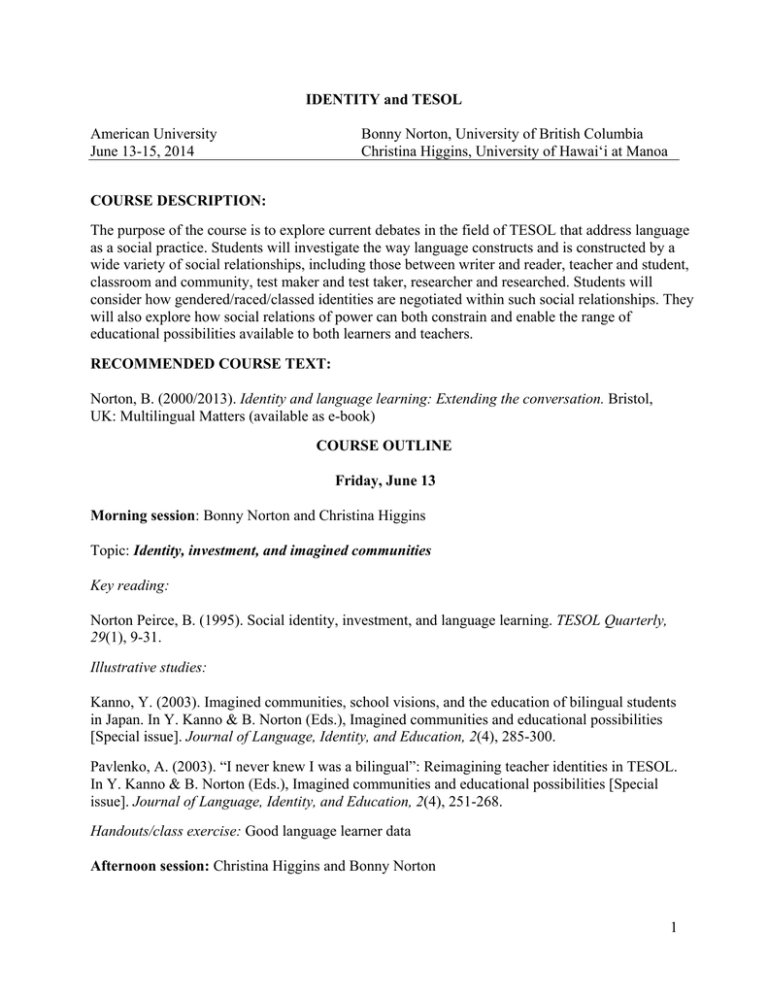American University Bonny
advertisement

IDENTITY and TESOL American University June 13-15, 2014 Bonny Norton, University of British Columbia Christina Higgins, University of Hawai‘i at Manoa COURSE DESCRIPTION: The purpose of the course is to explore current debates in the field of TESOL that address language as a social practice. Students will investigate the way language constructs and is constructed by a wide variety of social relationships, including those between writer and reader, teacher and student, classroom and community, test maker and test taker, researcher and researched. Students will consider how gendered/raced/classed identities are negotiated within such social relationships. They will also explore how social relations of power can both constrain and enable the range of educational possibilities available to both learners and teachers. RECOMMENDED COURSE TEXT: Norton, B. (2000/2013). Identity and language learning: Extending the conversation. Bristol, UK: Multilingual Matters (available as e-book) COURSE OUTLINE Friday, June 13 Morning session: Bonny Norton and Christina Higgins Topic: Identity, investment, and imagined communities Key reading: Norton Peirce, B. (1995). Social identity, investment, and language learning. TESOL Quarterly, 29(1), 9-31. Illustrative studies: Kanno, Y. (2003). Imagined communities, school visions, and the education of bilingual students in Japan. In Y. Kanno & B. Norton (Eds.), Imagined communities and educational possibilities [Special issue]. Journal of Language, Identity, and Education, 2(4), 285-300. Pavlenko, A. (2003). “I never knew I was a bilingual”: Reimagining teacher identities in TESOL. In Y. Kanno & B. Norton (Eds.), Imagined communities and educational possibilities [Special issue]. Journal of Language, Identity, and Education, 2(4), 251-268. Handouts/class exercise: Good language learner data Afternoon session: Christina Higgins and Bonny Norton 1 Topic: Linguistic identities and English as an international language Key reading: Alsagoff, L. 2012. Identity and the EIL learner. In L. Alsagoff, S. McKay, G. Hu, W. Renandya (eds.) Principles and practices for teaching English as an international language (pp. 104-122). Hoboken, NJ: Taylor & Francis. Illustrative studies: Jenkins, J. 2005. Implementing an international approach to English pronunciation: The role of teacher attitudes and identity TESOL Quarterly 39, 535-543. Park, G. 2012. “I am never afraid of being recognized as an NNES”: One teacher’s journey in claiming and embracing Her nonnative-speaker identity. TESOL Quarterly 46, 127-151. Handouts/class exercise: Linguistic identities Handouts 1-4 -----------------------------------------------------------------------------------------------------------Saturday, June 14 Morning session: Christina Higgins and Bonny Norton Topic: Narrative approaches in TESOL Key reading: Higgins, C. & P. Sandhu (2014). Researching identity through narrative approaches. In M. Bigelow & J. Ennser-Kananen (eds.) Handbook of Educational Linguistics (pp. 102-116). New York: Routledge. Illustrative studies: De Fina, A. & King, K. 2011. Language problem or language conflict? Narratives of immigrant women's experiences in the US. Discourse Studies 13, 163-188. Giroir, S. 2014. Narratives of participation, identity, and positionality: Two cases of Saudi Learners of English in the United States. TESOL Quarterly 48, 34-56. Handouts/class exercise: Narrative Handouts 1-3 Afternoon session: Bonny Norton and Christina Higgins Topic: Identity, literacy, and the multilingual classroom Key reading: 2 Norton, B (2014). Identity, literacy and the multilingual classroom. In S. May (Ed.) The Multilingual Turn: Implications for SLA, TESOL and Bilingual Education (pp. 103-122). New York: Routledge. Illustrative studies: Lam, W. S. E. (2000). L2 literacy and the design of the self: A case study of a teenager writing on the internet. TESOL Quarterly, 34(3), 457-482. Warriner, D.S. (Ed.). (2007). Transnational literacies: Immigration, language learning, and identity. Linguistics and Education, 18 (3-4), 201-214. Handouts/class exercise: Writing assessment: TOEFL and more -----------------------------------------------------------------------------------------------------------Sunday, June 15 Morning session: Bonny Norton and Christina Higgins Topic: TESOL and International Development Key reading: Norton, B. & Williams, C.J. (2012). Digital identities, student investments, and eGranary as a placed resource. Language and Education, 26, 4, 315-329. Illustrative studies: Lemphane , P. & Prinsloo, M. (in press). Children’s digital literacy practices in unequal South African settings. Journal of Multilingual and Multicultural Development Ramanathan, V. (2006). The vernacularization of English: Crossing global currents to re-dress West-based TESOL. Critical Inquiry in Language Studies, 3(2/3), 131-146. Handouts/class exercise: The African Storybook Project Afternoon session: Christina Higgins and Bonny Norton Topic: New Millennium Identities Key reading: Higgins, C. (2014). Intersecting scapes and new millennium identities in language learning Language Teaching. FirstView Article (April 2014) 1 – 17. Illustrative studies: Lin, A. & Man, E. 2011. Doing-hip-hop in the transformation of youth identities: Social class, 3 habitus, and cultural capital. In C. Higgins (ed.) Identity formation in globalizing contexts: Language learning in the new millennium (pp. 201-219). Berlin: Mouton de Gruyter. Song, J. 2012. Globalization, children’s study abroad, and transnationalism as an emerging context for language learning: A new task for language teacher education. TESOL Quarterly, 45, 749-758. Handouts/class exercise: New Millennium Handouts 1-3 4